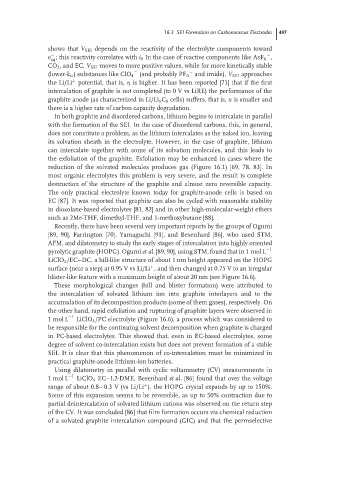Page 524 - Handbook of Battery Materials
P. 524
16.3 SEI Formation on Carbonaceous Electrodes 497
shows that V SEI depends on the reactivity of the electrolyte components toward
−
e ; this reactivity correlates with i 0 In the case of reactive components like AsF 6 ,
−
aq
CO 2 , and EC, V SEI moves to more positive values, while for more kinetically stable
−
(lower-k e ,) substances like ClO 4 (and probably PF 6 and imide), V SEI approaches
−
the Li/Li potential, that is, η is higher. It has been reported [71] that if the first
+
intercalation of graphite is not completed (to 0 V vs LiRE) the performance of the
graphite anode (as characterized in Li/Li x C 6 cells) suffers, that is, x is smaller and
there is a higher rate of carbon capacity degradation.
In both graphite and disordered carbons, lithium begins to intercalate in parallel
with the formation of the SEI. In the case of disordered carbons, this, in general,
does not constitute a problem, as the lithium intercalates as the naked ion, leaving
its solvation sheath in the electrolyte. However, in the case of graphite, lithium
can intercalate together with some of its solvation molecules, and this leads to
the exfoliation of the graphite. Exfoliation may be enhanced in cases where the
reduction of the solvated molecules produces gas (Figure 16.1) [69, 78, 83]. In
most organic electrolytes this problem is very severe, and the result is complete
destruction of the structure of the graphite and almost zero reversible capacity.
The only practical electrolyte known today for graphite-anode cells is based on
EC [87]. It was reported that graphite can also be cycled with reasonable stability
in dioxolane-based electrolytes [81, 82] and in other high-molecular-weight ethers
such as 2Me-THF, dimethyl-THF, and 1-methoxybutane [88].
Recently, there have been several very important reports by the groups of Ogumi
[89, 90], Farrington [70], Yamaguchi [91], and Besenhard [86], who used STM,
AFM, and dilatometry to study the early stages of intercalation into highly oriented
pyrolytic graphite (HOPG). Ogumi et al. [89, 90], using STM, found that in 1 mol L −1
LiClO 4 /EC–DC, a hill-like structure of about 1 nm height appeared on the HOPG
surface (near a step) at 0.95 V vs Li/Li , and then changed at 0.75 V to an irregular
+
blister-like feature with a maximum height of about 20 nm (see Figure 16.6).
These morphological changes (hill and blister formation) were attributed to
the intercalation of solvated lithium ion into graphite interlayers and to the
accumulation of its decomposition products (some of them gases), respectively. On
the other hand, rapid exfoliation and rupturing of graphite layers were observed in
1 mol L −1 LiClO 4 /PC electrolyte (Figure 16.6), a process which was considered to
be responsible for the continuing solvent decomposition when graphite is charged
in PC-based electrolytes. This showed that, even in EC-based electrolytes, some
degree of solvent co-intercalation exists but does not prevent formation of a stable
SEI. It is clear that this phenomenon of co-intercalation must be minimized in
practical graphite-anode lithium-ion batteries.
Using dilatometry in parallel with cyclic voltammetry (CV) measurements in
1 mol L −1 LiClO 4 EC–I,2-DME, Besenhard et al. [86] found that over the voltage
+
range of about 0.8−0.3 V (vs Li/Li ), the HOPG crystal expands by up to 150%.
Some of this expansion seems to be reversible, as up to 50% contraction due to
partial deintercalation of solvated lithium cations was observed on the return step
of the CV. It was concluded [86] that film formation occurs via chemical reduction
of a solvated graphite intercalation compound (GIC) and that the permselective

